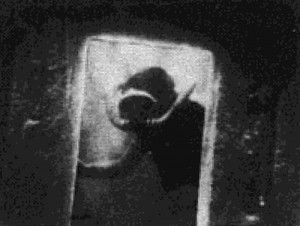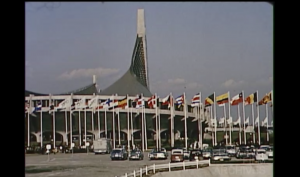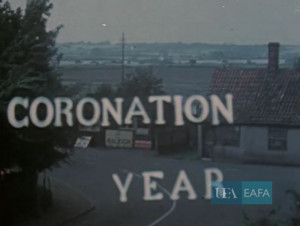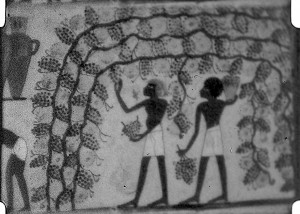"Three of Everything, the winner in Class C, is a cross section view of the advantages, equipment and materials the junior high school student finds today in a modern educational institution. Filmed at Mr. Gleason Junior High School in Sunland, Calif., the film depicts the print shop, the wood shop, the metal shop, the foundry, physical education, cooking classes, math and science, and finally graduation. With so much to assist his learning years, the film rightfully concludes that each student has, indeed, had three years of everything" PSA Journal, Sept. 1965, 51.
"Color film of a family picnic and riding in a model T." Church History Library.

"Tobermory Shipwrecks provides some good views of sunken ships in the Tobermory region, located at the northern tip of the southern Ontario peninsula that separates Lake Huron from Georgian Bay. Much of the underwater photography is well done, and the producer gives tips on underwater photographic equipment and how to use it" PSA Journal, Sept. 1965, 51.
"The Toilers, a 150 ft. Kodacolor reel made by Arthur G. Greaves, demonstrates the continuity possibilities of Kodacolor, a much neglected aspect of amateur color movies. Men at work — in the harbors, along the seacoast and inland, caring for flocks and harvesting grain — is the motif of the picture, relieved by a few glimpses of men and children at play. The picture is distinguished by beautiful photography of consistent quality and by a smooth succession of moving compositions in color. These qualities, combined with a clear continuity, give the film much more unity than is usual with Kodacolor reels. This is one of the all too few Kodacolor films that may be viewed as a subject possessing an artistic purpose as a whole, rather than as a series of separate scenes and sequences. Its chief color triumph is, perhaps, in the scenes of the harvesting against the background of fields of golden grain." Movie Makers, Dec. 1931, 658.

"The Tokyo Olympics, 1964 takes us to Tokyo and the Olympic games and provides us with a ringside seat for the numerous events that composed this athletic activity. Bad weather cannot be helped in a work of this kind, but the results in this picture did not suffer because of any inclement weather. For cut-aways we see the Emperor of Japan in his box, the smiling faces of the Orientals in the audience, and even an occasional glimpse of the cold drink hustlers charging 50 yen for a bottle of Coca Cola" PSA Journal, Sept. 1965, 51.
"Brickett Bridge, Andover Maine was built in 1871 of native spruce lumber. It served its purpose well until 1948 when it was replaced with steel and concrete." oldfilm.org

‘Camera pans over cottages in the village of Tolleshunt D’Arcy. Paintings of the coronation are shown followed by a photo of Queen Elizabeth II. A shot of the church with two old men sitting on a bench by the road. Another shot of the church followed by a sign post for the village and the Union Jack flag flying. A man goes into a telephone box in the middle of the village as a bus drives past. Flags and bunting decorate the village. Two women come out of a shop. One woman gets onto a bike and the other walks away. There is a shot of Tolleshunt D’Arcy Post Office and the postmistress, Miss Blaxhall, comes out under the filmmaker Joyce Allingham's direction. The baker puts up coronation decorations outside his shop and people put decorations on string around the village. A little girl waves a Union Jack flag. Close up of a girl and boy decorating pots using red, white and blue ribbon. Shots of people decorating their gardens. Two people come out of a Co-operative store and a little girl walks down the street carrying a basket. Mr and Mrs Emeny come out of the Thatcher’s Arms and another couple walk out of the front door of their cottage and smile at the camera. A woman wraps red, white and blue ribbon around her bird table and another woman carries a crown on a pillow. Camera pans across the street to show the villagers decorating. Children play in the street and a father lifts his little girl up to the camera and they both wave. People stand in a group and look at the camera. Miss Jessie Bacon looks through the window of Salter Lodge. Shot of the decorated D’Arcy Motors garage. The owner stands outside the garage where the Castrol oil and Esso petrol is sold. The proprietor, his wife and dog stand outside the Red Lion pub. Joyce’s sister, Margaret Allingham, and Margaret's husband, Philip Youngman Carter, stand outside their home in the main street. They then pose by the front door of D’Arcy House. Shot of a dog sitting in the garden. Close up of a woman hanging her washing on the line. Various shots of villagers going to church. A woman and her two children stand outside their home looking at the camera. A man climbs up a ladder to put up some bunting. Various villagers pose for the camera outside their homes and shops. One man cuts a rose and smells it. A car drives along the road followed by a shot of people coming out of a village shop. Shot of people looking out of the windows of the Queens Head pub and standing outside the tobacconist shop. Various shots of villagers standing outside shops and houses. A poster introducing the Tolleshunt D’Arcy Coronation Celebrations, June 2nd 1953 at the grounds of D’Arcy House. The poster states that there is a television in the village by Radio Vision, Maldon. It gives the line up of events for the day: Parade meet at The Maypole at 1.40pm followed by 3.45pm Sports; 4:30pm Sit Down Tea For Children; 5.00pm Running Buffet For Everyone; 5.40pm Sports Continued; 7.15pm Presentation of Prizes; 8.30pm Dancing in The Village. The procession of decorated lorries, vans, prams, cycles and fancy dress is shown. Camera pans over the people in the crowd dressed up in costumes. Close ups of the carnival floats driving past the camera. Children participate in various relay races. The film ends with scenes of a pram race with men dressed as women and the adult 'babies' drinking pints of beer’ (EAFA).
"How tomatoes change from blossom to fruit -- Frame by frame shots of tomato blossom giving birth to tomato -- Care of tomato plants." UC San Diego Library.

"The Tombs Of The Nobles, 400 ft., 16mm., is distinguished both in its subject matter and technical triumph over seemingly insuperable photographic odds. In it Mr. Hansen has achieved a clear and valuable record of Egyptian art and history as he found them presented on the interior walls of countless Egyptian tombs. Only by a careful placing and manipulation of sheets and mirrors in the cramped space of each tomb was Mr. Hansen able to cast sufficient light from the doorways onto the hundreds of paintings which he photographed. The film's continuity has been planned and edited in a simple, documentary style, adapted for use as an informal lecture subject. Its technical accomplishment seems unparalleled in the annals of amateur filming and has been well employed in recording subject matter entirely different from the general amateur picture." Movie Makers, Dec. 1931, 658.
Total Pages: 79